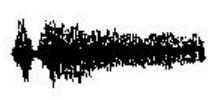Metro-Goldwyn-Mayer Lion Corporation’s Appeal relating to Community trade mark application No. 143891
Metro-Goldwyn-Mayer Lion Corporation’s Appeal relating to Community trade mark application No. 143 891
Case R 781/1999-4
In the said case, the Applicant sought to register the famous MGM Roar of Lion as a trade mark and represented the same through a spectrogram[1] in the application. The issue as to registrability arose as the subject application was not for music in traditional sense and hence musical notation (approved test for graphical representation of a sound mark in Shield Mark BV) was not available. The subject mark in the present case is reproduced herein below:

In the application the mark was described as “sound produced by the roar of a lion and is represented by the spectrogram abovementioned”. The examiner refused the registration on the following grounds:
- No correlation between reproduction of the mark and its description
- Public was not able to perceive the sound from the representation even if it read with the description.
- The description does not allow to reproduce clearly, precisely and unequivocally the sound as depicted.
- The mark does not fulfill the requirements of the function of a trade mark. It is not capable of distinguishing the goods or services of one from others. The public will not determine the origin of these goods upon sight of this mark. The sign applied for is not precise, clear and unequivocal enough to be perceived per se by the public as being a specific ‘roar of a lion’.
The Applicant filed an Appeal against the said decision. In December 2000, the appeal was re-allocated to the newly established Fourth Board of Appeal.
The Appeal was rejected as the sonogram was incomplete and had no representation of scale on time axis and alleged frequency axis. It was held that a pattern that cannot be read and therefore not understood, cannot be considered as a valid graphic representation of a mark.
Apart from the same, the Board of Appeal of OHIM held as follows on position of law of registering sound marks through sonograms or other methods which depict sound graphically such as oscillogram and spectrum:
- The fundamental registrability of sound marks is not disputed, as a trade mark may consist of a sign which is not in itself capable of being perceived visually, provided it can be represented graphically. [The Board relied on the Sieckmann Case]
- In this context, particular account should be taken of the high standards developed by the Court of Justice for the quality of the graphic representation which must be clear, precise, self-contained, easily accessible, intelligible, durable and objective.
- If the sound mark involves music in the traditional sense of the word, there is an obvious way to represent it graphically by representing the theme or composition by standard musical notation.
- On the other hand, the situation is different when it is not music, in the traditional sense of the word, but animal noises such as the roar of a lion or rolling thunder in a storm. Here, representation by musical notation regularly fails to work.
- Oscillogram would be suitable to represent a sound mark graphically only if it were exclusively a question of the strength (volume) of the signal, which is clearly not the case with sounds.
- A spectrum is also only a two-dimensional depiction of the distribution of a signal’s frequency content (vertical axis) versus frequency (horizontal axis). Therefore same would be suitable only if changes in frequency content over time were irrelevant, as is obviously not the case with sounds and noises.
- Graphic representation of a noise – such as a lion’s roar or a roll of thunder – by means of a sonogram results from analysis of the pitch (frequency), relative volume (frequency content) and progression over time of the sound occurrences. Accordingly, representation by means of a sonogram is comparable with representation using musical notation.
Hence, the Board was of the view that a sound mark can be graphically represented by way of a sonogram in the event musical notations are not possible or not utilised for the purpose of applying.
[1] A spectrogram is a visual representation of the spectrum of frequencies of a signal as it varies with time. When applied to an audio signal. spectrograms are sometimes called sonographs, voiceprints, or voicegrams. Spectrograms are used extensively in the fields of music, sonar, radar and speech processing, seismology and others. Spectrograms of audio can be used to identify spoken words phonettically and to analyse the various calls of the animals. (Source: https://en.wikipedia.org/wiki/Spectrogram) (Last Accessed on: 30th December, 2019)

